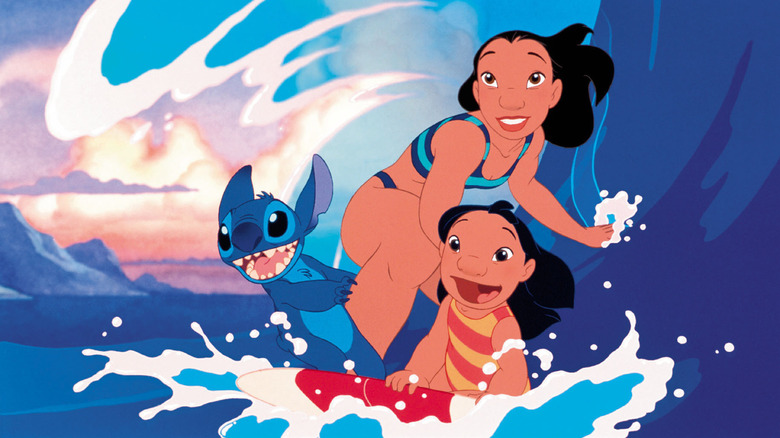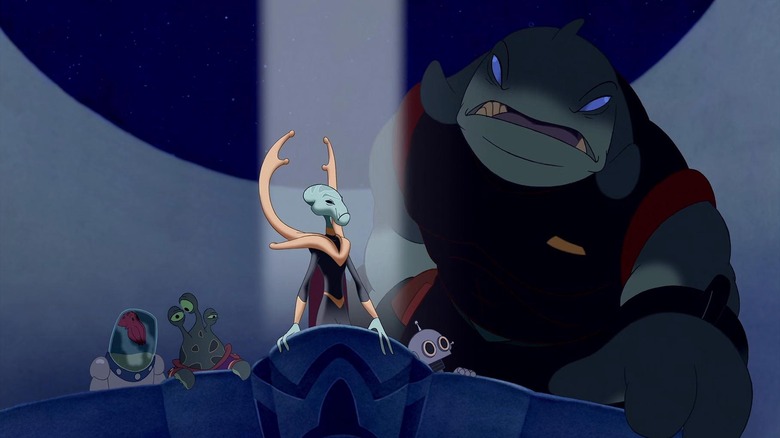Disney's Lilo & Stitch Originally Wasn't Supposed To Be A Movie
Disney's watercolor masterpiece "Lilo & Stitch" has grown to become one of the studio's most iconic films since its theatrical release in 2002, particularly in comparison to other movies from the Mouse House's early 2000s fallow period (which was marked by flops like "Fantasia 2000" and "Treasure Planet"). The story of one dysfunctional family's interstellar pet, "Lilo & Stitch" captured our hearts with its vivid characters, who exist in a world that includes both zany science-fiction aliens and deeply felt human emotions.
Indeed, virtually all of Disney's previous live-action retellings have re-imagined its classic films from the 20th century, ranging from "Snow White" to "Beauty and the Beast." Now, the live-action (or, more accurately, "live-action assisted by CGI animation") "Lilo & Stitch" remake has not only become a box office juggernaut, but it also marks the first 2000s era Disney animated feature to receive a big-budget makeover.
This moment feels like the canonization of the original "Lilo & Stitch" in the pantheon of Disney's greatest animated films. As such, it's interesting to learn that Chris Sanders — who co-directed and co-wrote the animated "Lilo & Stitch" in addition to providing Stitch's iconic voice — didn't initially envision the project as a movie at all, as he explained in an oral history of the film by Vulture.
Stitch originated in an 'abandoned' children's book
The Hawaiian culture and landscape is so ingrained in the story of "Lilo & Stitch" that it is hard to imagine it taking place anywhere else. But in Vulture's oral history of the film's production, Chris Sanders told the story of how he had originally created the concept for an entirely different medium and setting:
"17 years prior to me even pitching 'Lilo & Stitch,' I wanted to do a children's book about this little creature that lived in a forest. It was a bit of a monster with no real explanation as to where it came from. It was all about how he found a way to belong. But after doing a couple of drawings, I realized the idea was going to be very difficult to squeeze down to, say, 24 pages. So, I abandoned it."
Stitch as a monster in the forest makes a lot of sense in retrospect, considering how many fairy tales follow a similar path. However, that was also clearly why Sanders and his collaborators decided to move in a different direction, eventually landing on the idea of the monster being an alien from another planet. Ultimately, that decision necessitated a change in scenery when Thomas Schumacher, a creative executive at Disney, remarked, "You don't want him to be living in a world full of animals who don't know what an alien is. An alien among animals is not as remarkable as an alien among humans."
Sanders agreed, especially when Schumacher showed him the beauty of the Hawaiian islands and the spectacular combinations of color that can be found there. Sanders started ideating on the concept and, in the process of creating this new alien, found himself going full circle to where the story began:
"I thought, If I say 'alien,' everyone's going to have a different interpretation as to what that is. So, I'm going to do a book that has drawings in it so they understand. I created, in a sense, that children's book."
Over the following years, the team created the film from the distant Florida outfit of Disney Animation Studios (away from the prying eyes of studio honchos), and the results speak for themselves. "Lilo & Stitch" lives on through an ever expanding series of movies, specials, and TV shows, and, yes, also children's books.

